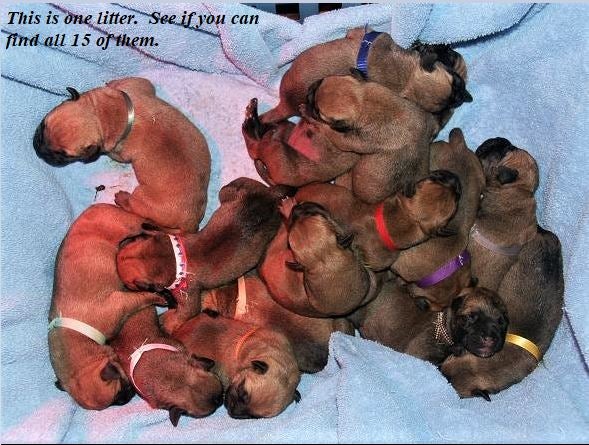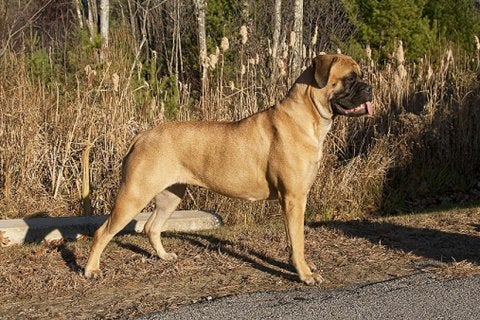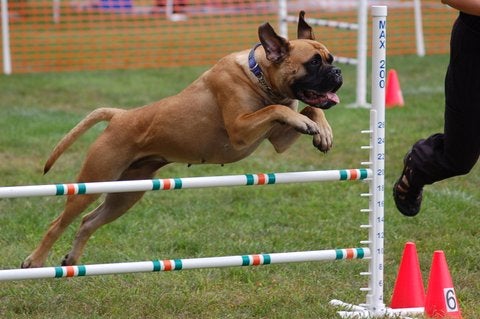
StoneBull BullMastiffs is a small hobby kennel located in the southwest corner of New Hampshire. Owners Steve Krulish and Jackie Smith have been involved in Bullmastiffs since 1989. With each litter, they say that their goals remain the same: to produce sound, healthy puppies that are good examples of the breed and who will enrich the lives of their new families.
AKC: How did you get started in breeding dogs?
Steve: In 1989, we had four young boys and thought it would be good to bring a dog into the family. We both had dogs growing up and felt caring for a non-human living being gives kids a good sense of responsibility as well as empathy for all creatures. We did some research via magazines and an AKC book on purebred dogs in our library (life before the internet), and it seemed that a Bullmastiff would be a good fit for us as a family. We attended some dog shows to see them in person, then found a breeder through the classified section of a dog magazine. We acquired a puppy and began a wonderful long-term mentor relationship with the breeder. We soon discovered that doing dog-related activities together as a family was a lot of fun, so a second Bullmastiff soon followed and StoneBull Bullmastiffs was launched.

What is the most important thing to know about Bullmastiffs?
Steve: Bullmastiffs are not the best choice for the first-time dog owner. This is a working breed, and while they all have individual personalities just like every other breed, they do remain true to their working dog nature and therefore require a firm, consistent hand. They are somewhat suspicious of strangers, protective of their family, and property (including patrolling against marauding small furry creatures such as squirrels, chipmunks, and skunks) and are intensely loyal with long memories, including remembering people they have not seen for years. Bullmastiffs are not pack animals and do not feel the need to have other doggie friends, but rather crave human companionship. They are not a breed that can be tied out but they need a secure, fenced-in area to exercise. They benefit greatly from obedience classes and lots of socialization (properly supervised) as young adults. Many Bullmastiffs can have a high prey drive and may not be the best choice for a family with cats or very small dogs, and we highly discourage taking a Bullmastiff to a dog park.
How has AKC Marketplace helped you find puppy buyers?
Steve: The inquiries we’ve received are almost always from folks who have done a good amount of research, not only on the breed but also about us. The AKC Marketplace helps in matching up the experience that potential puppy buyers expect to have when looking for their forever companion, to breeders who are looking for a long-term, supportive relationship with their clients.
What is your favorite question to ask of potential puppy buyers?
Steve: Because we firmly believe it’s best to match the puppy’s inherent personality with his or her new family’s expectations and lifestyle, we ask families to tell us about themselves and why they feel a Bullmastiff is the right choice for them. Puppies are individually temperament-tested using the Puppy Personality Profile Test, and these results are used to match each puppy’s inherent personality with its new family’s lifestyle and expectations for the puppy.

What are the main qualities you look for in potential owners?
Steve and Jackie: It takes a certain kind of human temperament for a Bullmastiff to thrive in a family. We look for folks who are comfortable setting realistic expectations for training and behaviors and have consistent follow through. For example, if the family’s rule is the dog will never be allowed on the furniture, then it can never be allowed on the furniture – even in those one-time instances where someone is having a bad day and looking for some snuggle time with the dog. Bullmastiffs do best when “no” always means “no” and never “maybe.” They, like children, tend to be quite literal in that regard. Being “wishy-washy” with a Bullmastiff sets them and the family up for unfair expectations. If it is a family with children, we watch how the children behave and how the parents interact with their children. We look for potential owners who understand that they will need to be a positive advocate for the breed and their dog.
What is the best advice you would give to novice breeders?
Steve: Find a mentor who shares your values and listen to them! With your mentor, evaluate the strong and weak points of your bitch and decide what you should be looking for in a stud dog. Good mentors have been in the breed a long time, will work with you through all the ins and outs of breeding Bullmastiffs, and will be there for you, day or night, to get you through your first litter. Breeding Bullmastiffs is a big commitment in terms of time and effort, as this is not a breed in which you can expect mom to safely whelp her puppies on her own and care for them until they’re ready to go to their new homes. This is a labor intensive, hands-on endeavor, and requires a human support staff. Talk to other Bullmastiff breeders as well and ask for their feedback. Make a list of everything you may need and check with your mentor about anything you may have overlooked. Get all your supplies together and be prepared beforehand! Unless you have a scheduled C-section, moms can go into labor at inopportune times. Make sure you’re ready no matter what. Have a notepad to take notes about the puppies because after a day or two of disrupted sleep, there’s a good chance you will find it hard to remember which puppy did what.
Do your dogs participate in AKC sports?
Steve: Yes; besides conformation, we compete in obedience, rally, agility, coursing, and dabble a bit in tracking. In 2015, one of our dogs earned her AKC Master Agility Championship two days short of her ninth birthday and was the number one Bullmastiff in AKC Agility that year. Dog sports are a great way to form an even closer bond with any dog, but especially a Bullmastiff due to their need to be with their family. We encourage all owners to attend training classes, not necessarily with a goal of competing, but as a way of socializing their dogs, building the dog’s confidence, and having fun.

What do you like best about breeding dogs?
Steve: It is best when the puppies reach about four to five weeks old and are noticing and exploring their surroundings. We create a collection of appropriately sized agility equipment for the puppies, and it is fascinating, watching them investigate and learn to control their bodies. It gives us a chance a watch them interact with each other and see how they react to different stimuli. Taking puppies out for their first “follow-me” game” on a short walk on our property is a blast! Puppies are loads of fun.
Do you have a favorite breeding story?
Steve: That would have to be our litter of 16 puppies that had to be bottle fed, as mom just couldn’t keep up with the demand of all those hungry mouths. It wound up being a 24/7 job that involved a massive support system from our friends and family! By the time we fed them, cleaned them, and cleaned up after them, it was time to begin the next feeding cycle. Doing their nails always put us behind schedule. However, being swarmed by a giant pack of joyous loving puppies made it all worthwhile.

